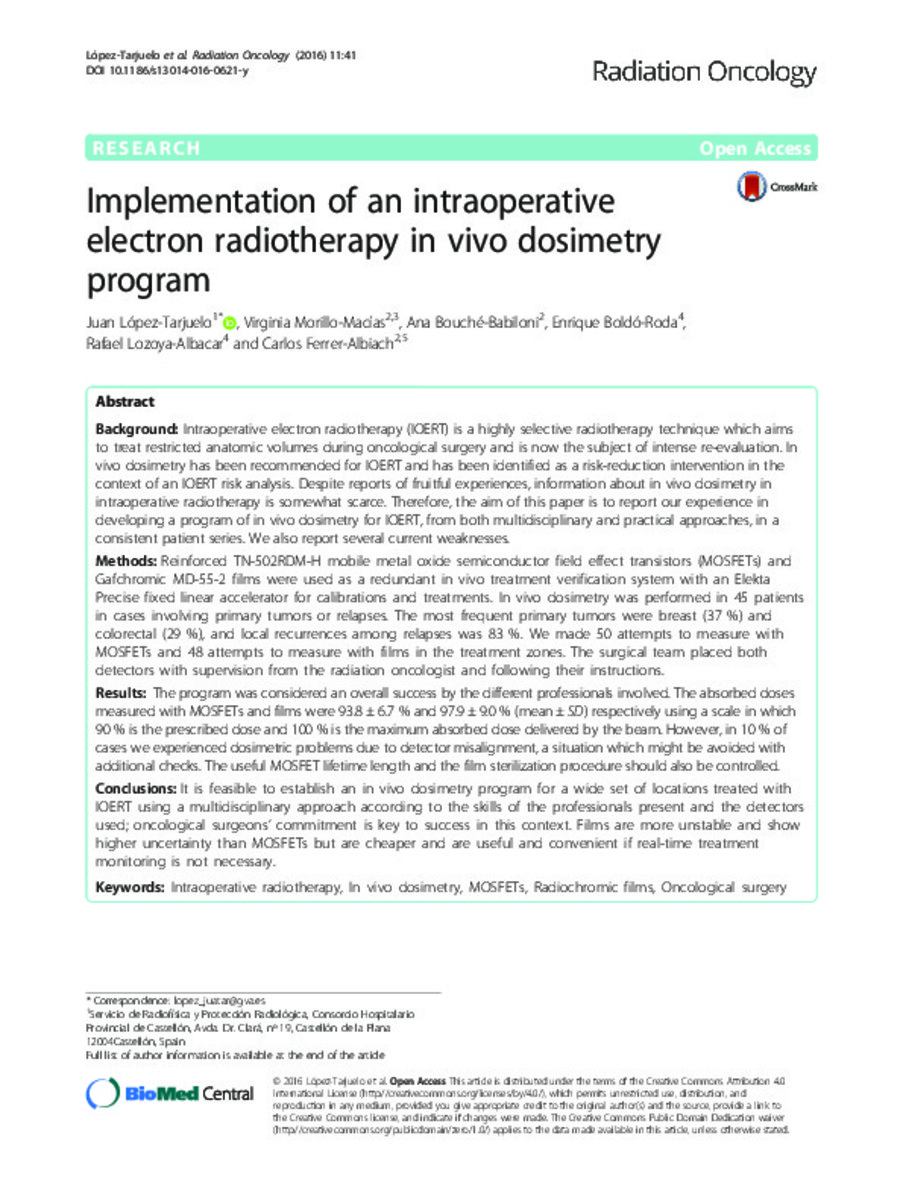Mostrar el registro sencillo del ítem
Implementation of an intraoperative electron radiotherapy in vivo dosimetry program
| dc.contributor.author | López-Tarjuelo, Juan | |
| dc.contributor.author | Morillo Macías, Virginia | |
| dc.contributor.author | Bouché Babiloni, A. | |
| dc.contributor.author | Boldó, Enrique | |
| dc.contributor.author | Lozoya Albacar, Rafael | |
| dc.contributor.author | Ferrer Albiach, Carlos | |
| dc.date.accessioned | 2017-06-27T15:13:47Z | |
| dc.date.available | 2017-06-27T15:13:47Z | |
| dc.date.issued | 2016 | |
| dc.identifier.citation | López-Tarjuelo, J., Morillo-Macías, V., Bouché-Babiloni, A., Boldó-Roda, E., Lozoya-Albacar, R., & Ferrer-Albiach, C. (2016). Implementation of an intraoperative electron radiotherapy in vivo dosimetry program. Radiation Oncology, 11(1), 41 | ca_CA |
| dc.identifier.issn | 1748-717X | |
| dc.identifier.uri | http://hdl.handle.net/10234/168117 | |
| dc.description.abstract | Background: Intraoperative electron radiotherapy (IOERT) is a highly selective radiotherapy technique which aims to treat restricted anatomic volumes during oncological surgery and is now the subject of intense re-evaluation. In vivo dosimetry has been recommended for IOERT and has been identified as a risk-reduction intervention in the context of an IOERT risk analysis. Despite reports of fruitful experiences, information about in vivo dosimetry in intraoperative radiotherapy is somewhat scarce. Therefore, the aim of this paper is to report our experience in developing a program of in vivo dosimetry for IOERT, from both multidisciplinary and practical approaches, in a consistent patient series. We also report several current weaknesses. Methods: Reinforced TN-502RDM-H mobile metal oxide semico nductor field effect tran sistors (MOSFETs) and Gafchromic MD-55-2 films were used as a redundant in vivo treatment verification system with an Elekta Precise fixed linear accelerator for calibrations and tre atments. In vivo dosimetry was performed in 45 patients in cases involving primary tumors or relapses. The m ost frequent primary tumors were breast (37 %) and colorectal (29 %), and local recurrences among relapses was 83 %. We made 50 attempts to measure with MOSFETs and 48 attempts to measure with films in th e treatment zones. The surgical team placed both detectors with supervision from the radiation oncologist and following their instructions. Results: The program was considered an overall success by the different professionals involved. The absorbed doses measured with MOSFETs and films were 93.8 ± 6.7 % and 97.9 ± 9.0 % (mean ± SD ) respectively using a scale in which 90 % is the prescribed dose and 100 % is the maximum absorbed dose delivered by the beam. However, in 10 % of cases we experienced dosimetric problems due to detector misalignment, a situation which might be avoided with additional checks. The useful MOSFET lifetime length and the film sterilization procedure should also be controlled. Conclusions: It is feasible to establish an in vivo dosimetry program for a wide set of locations treated with IOERT using a multidisciplinary approach according to the skills of the professionals present and the detectors used; oncological surgeons ’ commitment is key to success in this context. Films are more unstable and show higher uncertainty than MOSFETs but are cheaper and are useful and convenient if real-time treatment monitoring is not necessary. | ca_CA |
| dc.description.sponsorShip | This work was supported by grants IPT-300000-2010-3 and PI11/01659 from the Spanish Government and ERDF funds. | ca_CA |
| dc.format.extent | 7 p. | ca_CA |
| dc.format.mimetype | application/pdf | ca_CA |
| dc.language.iso | eng | ca_CA |
| dc.publisher | BioMed Central | ca_CA |
| dc.relation.isPartOf | Radiation Oncology, 2016, vol. 11, núm. 1 | ca_CA |
| dc.rights | © 2016 López-Tarjuelo et al. Open Access This article is distributed under the terms of the Creative Commons Attribution 4.0 International License (http://creativecommons.org/licenses/by/4.0/), which permits unrestricted use, distribution, and reproduction in any medium, provided you give appropriate credit to the original author(s) and the source, provide a link to the Creative Commons license, and indicate if changes were made. The Creative Commons Public Domain Dedication waiver (http://creativecommons.org/publicdomain/zero/1.0/) applies to the data made available in this article, unless otherwise stated. | ca_CA |
| dc.rights | Atribución 4.0 Internacional | * |
| dc.rights.uri | http://creativecommons.org/licenses/by-sa/4.0/ | * |
| dc.subject | Intraoperative radiotherapy | ca_CA |
| dc.subject | In vivo dosimetry | ca_CA |
| dc.subject | MOSFETs | ca_CA |
| dc.subject | Radiochromic films | ca_CA |
| dc.subject | Oncological surgery | ca_CA |
| dc.title | Implementation of an intraoperative electron radiotherapy in vivo dosimetry program | ca_CA |
| dc.type | info:eu-repo/semantics/article | ca_CA |
| dc.identifier.doi | https://doi.org/10.1186/s13014-016-0621-y | |
| dc.rights.accessRights | info:eu-repo/semantics/openAccess | ca_CA |
| dc.relation.publisherVersion | https://ro-journal.biomedcentral.com/articles/10.1186/s13014-016-0621-y | ca_CA |
| dc.type.version | info:eu-repo/semantics/publishedVersion |
Ficheros en el ítem
Este ítem aparece en la(s) siguiente(s) colección(ones)
-
MED_Articles [637]
Articles de publicacions periòdiques
Excepto si se señala otra cosa, la licencia del ítem se describe como: © 2016 López-Tarjuelo et al.
Open Access
This article is distributed under the terms of the Creative Commons Attribution 4.0
International License (http://creativecommons.org/licenses/by/4.0/), which permits unrestricted use, distribution, and
reproduction in any medium, provided you give appropriate credit to the original author(s) and the source, provide a link to
the Creative Commons license, and indicate if changes were made. The Creative Commons Public Domain Dedication waiver
(http://creativecommons.org/publicdomain/zero/1.0/) applies to the data made available in this article, unless otherwise stated.








